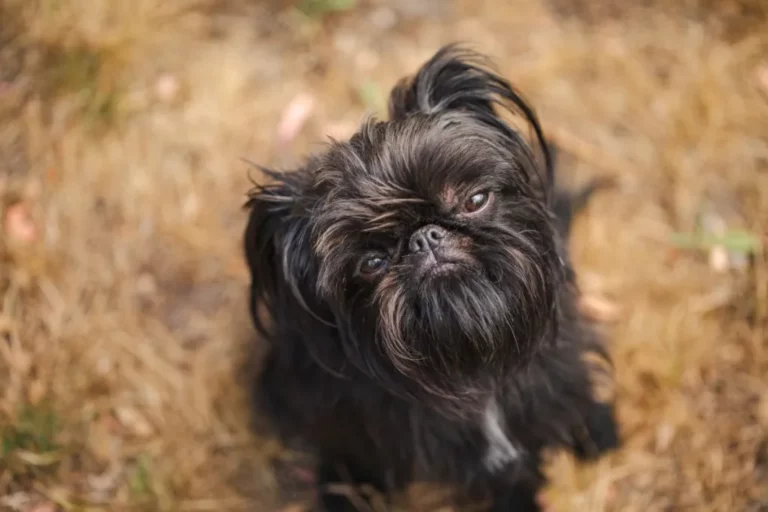Brussels Griffon Dog Breed Information
The Brussels Griffon is a small dog breed with roots in Belgium, known for its unique look and history as both a companion and a skilled hunter of vermin.
Showing off a pronounced chin and expressive eyes, the breed displays a charming, almost human-like appearance in their puppy stage or as an adult dog. These dogs come with either a smooth or a rough coat.
Despite their small size, Brussels Griffons show strength and agility, which, in the past, made them excellent griffon secure, a term used for a stable dog controlling rodents. Nowadays, their loyal and energetic natures have earned Brussels Griffons the affectionate nickname
They’re intelligent and attentive adult dogs, but their tendency to bark may require consistent dog training. Living typically between 12 to 15 years, Brussels Griffons enjoy a close bond with their owners and need regular grooming.
Whether as a puppy or an adult dog, they fit into the heart of family life.
Key Takeaways
- Belgian Brussels Griffons charm with human-like faces and varied coats.
- Lively and loyal, these dogs integrate well into family settings.
- Intelligent and agile, they require consistent training and regular grooming.
Brussels Griffon puppies, bred originally in Belgium, boast a distinctive appearance and an impressive history of vermin hunting. Their expressive eyes and notable chins contribute to their endearing look, available in smooth or rough coat variations. Once skilled as a natural griffon d’ecurie in rodent control, they now shine as affectionate family companions, earning them the nickname of Alert and clever. These small dogs tend to bark, which can be managed with regular training. With a 12 to 15-year lifespan, they form bonds with their owners, which are “as good as it gets” and require consistent grooming to maintain their glossy or rough coat’s appearance and health. Whether as a puppy or an adult dog, they quickly become an integral part of the household, solidifying their status as the breeder’s favored breed.
Quick Facts
The Brussels Griffon, also known as the Griffon Bruxellois, is a charming toy dog breed with a sturdy build and a face many say resembles a human’s. This dog originated in Belgium and is known for its adaptability, making it ideal for both large homes and small apartments.
With a unique look defined by its short, rough coat available in colors like a deep red, this breed has won the hearts of many as a lovable companion. Owners should be aware that Brussels Griffons are prone to health issues such as knee problems and eye conditions, so regular check-ups with a vet are advised to keep them healthy.Brussels Griffon Pictures
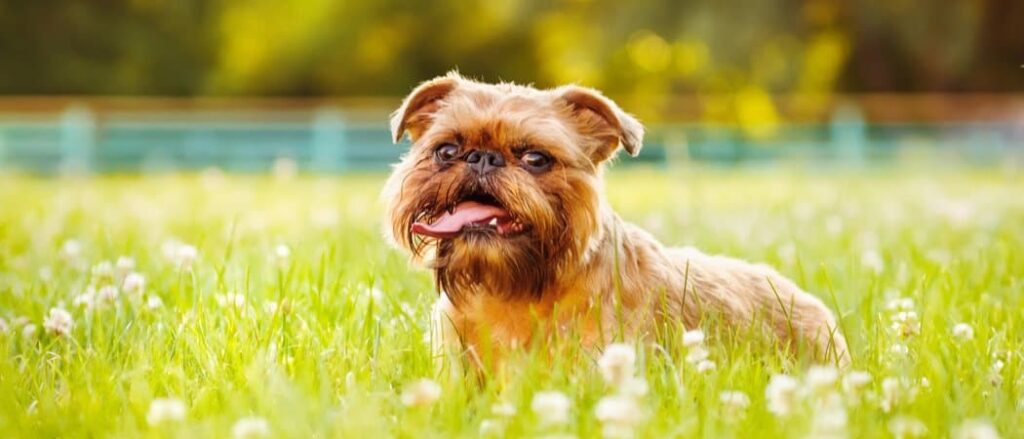
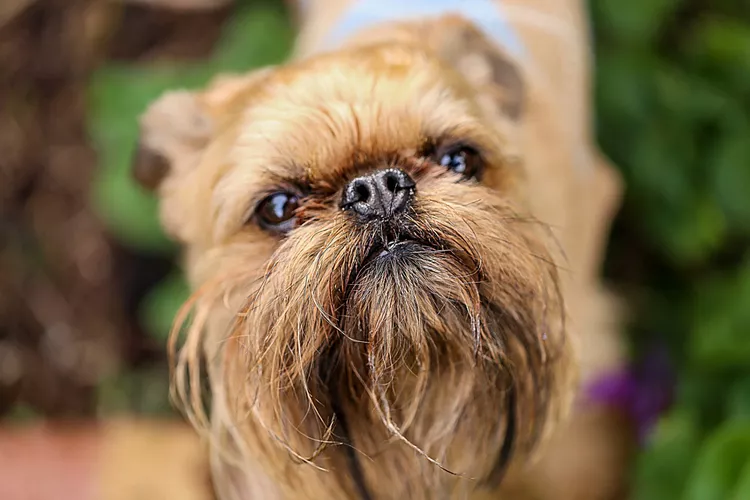
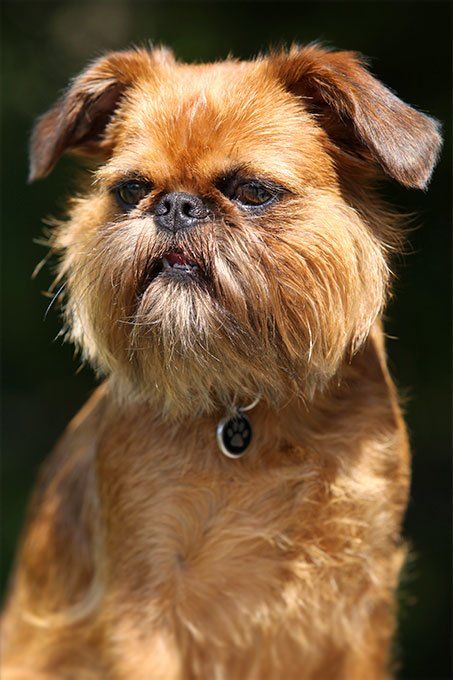

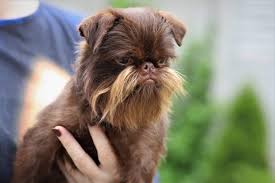
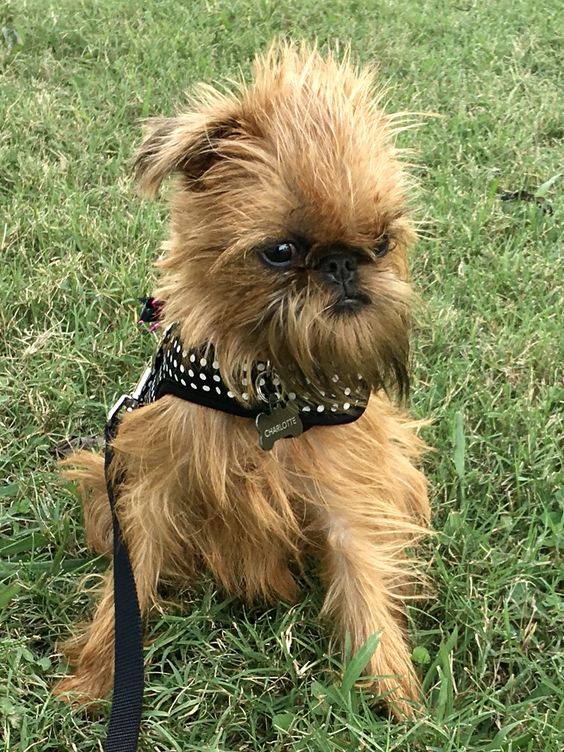
Overview
Known for its affectionate nature, the Brussels Griffon is a charming and intelligent breed that adapts well to various living spaces.
Hailing from Belgium, this compact breed boasts a distinctive look with a rounded head, big, soulful eyes, and a short muzzle, and comes in two coat types: wiry or smooth.
These dogs stand about 10-12 inches tall and tip the scales at 7-12 pounds, with a life expectancy of about 12 to 15 years.
Perfect for first-time owners and those living in apartments, the Brussels Griffon is friendly and alert and makes a reliable little watchdog.
Their size and friendly nature make them great for smaller homes or city living.
Breed Key Features
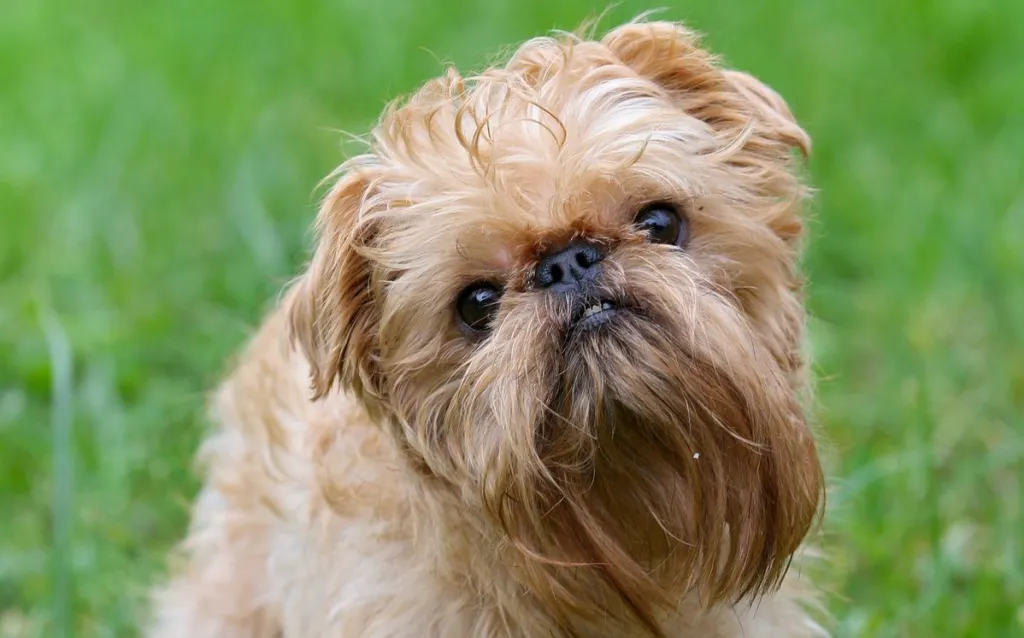
The Brussels Griffon may be small, but it’s known for its distinctive face, complete with large, soulful eyes and a tiny, skyward nose that looks similar to a human’s. The Griffo breed might be petite, but it exudes an intelligent and friendly vibe, always appearing eager and curious.
You’ll find their coat in two types: the rough one, with a textured feel, and the smooth one, which is sleeker and easier to maintain.
Regarding their size, Brussels Griffons typically stand between 10 and 12 inches tall and weigh 7 to 12 pounds, making them ideal for the toy dog category. Their wiry or smooth coats influence how much care they’ll need and their potential to cause allergies.
Those big eyes aren’t just for show but essential for human communication. Meanwhile, their short noses, a breed trait, affect their breathing.
As for their personality, these dogs are known for being playful and intelligent, which suggests they can form strong social bonds and are usually easy to train.
Breed Origin Story
The Brussels Griffon has an intricate history, originating from Belgium’s cobbled streets and rising to become a cherished pet among European elites. Its lineage includes a mix of breeds like the Smousje, Pug, and King Charles Spaniel that shaped its current form, perfect for companionship and practical roles.
The story of the Brussels Griffon is deeply rooted in its Belgian origins, especially its namesake city of Brussels. These small dogs were first bred to catch rats and keep company in horse-drawn carriages. Over time, they transitioned into beloved pets, often seen in the company of Belgian nobility during the 19th century.
This rise in status helped the Brussels Griffon become well-known and admired for its distinct personality and appearance.
Ancestral Breed Influences
Selective breeding in 19th-century Belgium led to the creation of the Brussels Griffon, a small yet robust dog. These dogs, originally from the Smousje breed known for hunting rodents, were later mixed with the Pug and King Charles Spaniel, giving them their distinctive red and black coats.
The Brussels Griffon, like the Belgian Griffon and Petit Brabancoe, gained different looks. Queen Marie Henriette’s support made the breed well-liked across other social classes in Belgium, making it a favorite among the nobility and the ordinary people.
Historical Purpose/Function
The Brussels Griffon, hailing from 17th century Brussels, had a specific job: hunting and eradicating rodents in the city’s stables and homes. This small, energetic dog, once known as a Smousje, was a prolific ratter.
The breed transformed when Pugs and King Charles Spaniels were introduced, improving its physical traits. In 1883, the breed achieved formal recognition, establishing it in the annals of dog breeding.
Around the time before World War I, the Brussels Griffon gained popularity and was showcased at a prominent dog show in Brussels. Queen Marie Henriette’s admiration for these dogs significantly affected their rising status.
Over time, the breed transitioned from vermin hunter to beloved pet, a change officially noted by the American Kennel Club in 1910.
Geographic Origins
In the vibrant city of Belgium during the 17th century. Initially bred to hunt rodents, their effectiveness made them popular among the working class.
As time passed, even royalty, like the charming Brussels Griffon, including Queen Marie Henriette, elevated its status across Belgium.
This love for the breed wasn’t contained to just Belgium; as its reputation grew, so did its international presence, with enthusiast clubs forming in England and the United States by the late 1800s.
Physical Dimensions
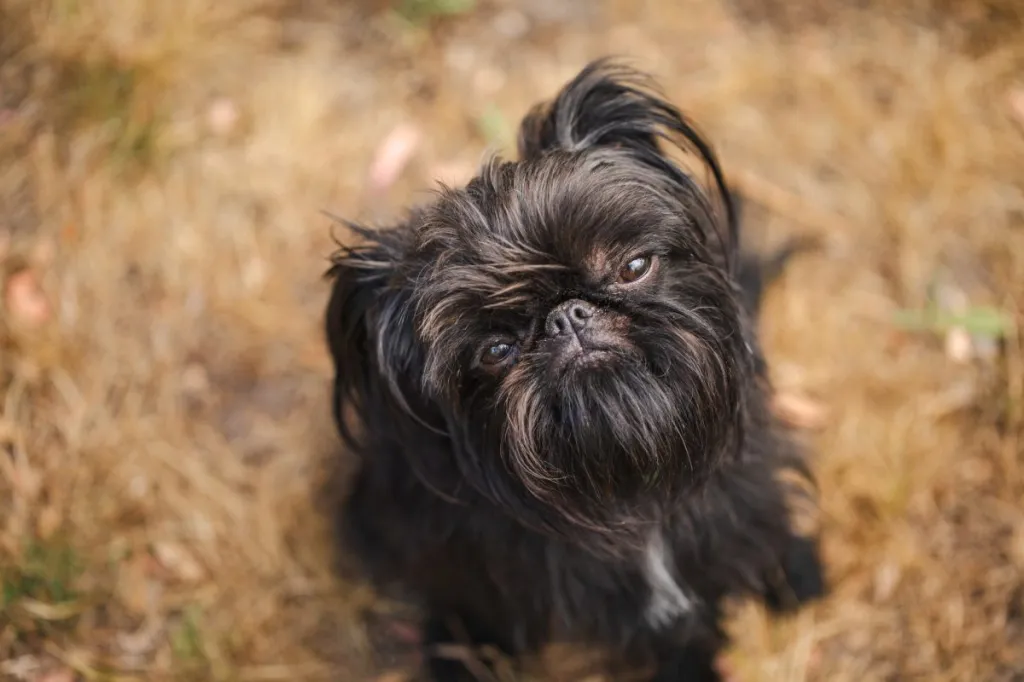
Brussels Griffons stand out due to their unique size and shape, making them a perfect fit for various living situations. These small dogs typically stand about 7 to 10 inches tall at the shoulder. They weigh in at a light 8 to 10 pounds, showcasing their petite build.
Their bodies are well-proportioned, with a square silhouette, deep chest, and sturdy back, giving them a robust appearance despite their small size. A Brussels Griffon’s coat can be rough or smooth, requiring a specific grooming routine.
Knowing their physical characteristics helps potential owners understand what to expect and how to care for these dogs.
Average Height Range
Brussels Griffons are small yet sturdy dogs, standing at a height of 7 to 10 inches at the shoulder. Their well-proportioned bodies and muscular build give them a solid appearance that belies their size.
These dogs are consistent in height, making them a perfect fit for smaller living spaces like apartments. Their size makes them versatile companions for those with limited room but who still want a dog with a big personality.
Weight Classification
Brussels Griffons, a toy breed, generally weigh between 8 and 12 pounds, showcasing a solid build that can even reach 20 pounds in some dogs.
These small, short-nosed dogs are well-known for their sturdy and muscular frames despite their small height of just 7 to 8 inches at the shoulder. Their body mass is impressive for their overall size, reflecting their robust and boxy shape.
The health of Brussels Griffons needs to keep their weight in check, as any extra pounds can lead to serious health problems, especially with their breathing and joints due to their brachycephalic nature.
Body Shape Characteristics
Brussels Griffons are known for their square-shaped bodies, broad chests, and sturdy back legs. These small dogs stand out with their short noses and big, round eyes that give them a look that many say is akin to a person’s.
Despite their small size, Brussels Griffons are strong and can move with impressive speed and agility. Owners should keep an eye on their dog’s weight and body shape, as their structure can lead to hip dysplasia—an issue where the hip joints don’t form properly, hindering their movement.
Keeping track of their health is critical to living a whole and active life.
Coat Length Variations
Brussels Griffons come in two coat lengths: the rough-coated variety with its wiry and dense fur and the smooth-coated type, known for its shorter and more refined coat.
Weekly brushing is necessary for the rough-coated Brussels Griffon to keep its fur neat and prevent tangles. Regular grooming, which may entail stripping or trimming, is critical to maintaining the wiry texture of this coat.
On the other hand, the smooth-coated Brussels Griffon has a low-maintenance coat that’s straight, short, and shiny, with only moderate shedding.
Grooming isn’t just about looks; it’s vital to keeping these dogs healthy and happy.
Size Comparison Breeds
When you compare the Brussels Griffon to other small dog breeds, it’s clear that they’re on the tinier end of the spectrum. This charming breed stands just 7 to 10 inches tall at the shoulder and usually weighs between 8 and 10 pounds.
Despite their small size, they have a well-built structure, including solid hips that support their body and allow for good movement. Their unique short noses and expressive faces set them apart from other toy breeds.
While most Brussels Griffons are pretty uniform, you might find a few slightly heavier, tipping the scales at around 12 pounds. This variation shows that even within a small breed, there can be some differences in size.
Temperament Traits
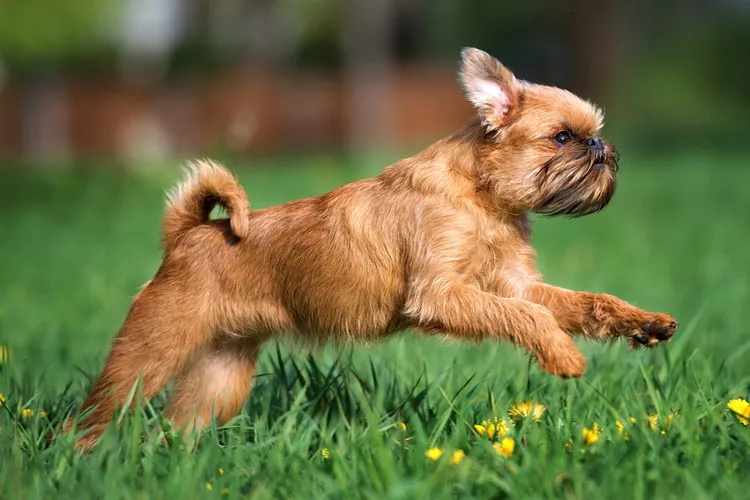
Understanding the Brussels Griffon involves understanding their distinct personality and how it fits within a household. These small dogs are full of affection and have a strong bond with their owners, making them loving members of the family.
However, their smarts sometimes come with a side of stubbornness during training, so patience is vital. They must also interact with people regularly to stay happy and emotionally healthy.
Lastly, Brussels Griffons make keen and observant watchdogs, always on alert, but typically don’t show aggression.
Affectionate Companion Nature
Brussels Griffons are known for their deep affection and loyalty, often forming a special bond with one person in the family. These small dogs love to stay close to their owners, earning them the nickname ‘Velcro dogs.’
Studies have shown that they thrive on social interaction and are well-suited for family life. They’re also patient and gentle with children, making them lovable additions to any home.
For a Brussels Griffon to truly flourish, they need a caring and loving home environment.
Stubbornness Training Challenges
Brussels Griffons, while loving by nature, often show a determined personality that makes training them challenging. Their strong-willed character can make it difficult for them to follow standard obedience training. During classes, it’s clear that these dogs might not engage well with repetitive commands that they find boring.
Housebreaking a Brussels Griffon is particularly tricky, requiring a mix of consistent positive rewards and patient instruction. Their bold character needs a balanced training style—assertive yet encouraging—to prevent them from feeling discouraged. For training to work, owners must be consistent and establish themselves as leaders.
Doing so can help overcome the dog’s stubborn behavior, leading to a peaceful relationship between the pet and its owner.
Social Interaction Needs
Brussels Griffons are social butterflies with a strong need for companionship. Their assertive nature might make them try to boss around bigger dogs, reflecting their understanding of social rankings.
These little dogs are also susceptible, needing the steady presence of their owners to feel secure and happy. If they’re left by themselves too much, they could get anxious and start barking a lot. They’re not the best fit for homes where people are away for long hours.
As part of a family, Brussels Griffons form deep bonds and love being involved in daily activities, which helps them feel part of a loving pack.
Alert Watchdog Behavior
Brussels Griffons are excellent at looking for anything unusual, thanks to their sharp sense of awareness. These small dogs may be little, but they don’t hesitate to let their owners know when a stranger is around, making them effective watchdogs. Their natural curiosity, sharp senses, and desire to protect their territory mean they quickly detect possible dangers.
These dogs are exceptionally great with families, forming strong bonds and helping to keep the home safe. However, their tendency to bark alerts means owners should invest time in training to keep their barking under control. This ensures that their attentiveness is helpful and not disruptive.
Gentle Family Pet
The Brussels Griffon is a friendly and patient breed, perfect for families looking for a loving pet. These small dogs connect well with children, often showing a caring and protective side. Their innovative nature means they quickly get used to family routines and enjoy fun activities, like playing fetch. They form deep bonds with their families, giving back the love they receive with unwavering loyalty.
Living in a city apartment doesn’t stop a Brussels Griffon from being a great pet because they don’t need a lot of exercise. This makes them an excellent choice for families living in busy urban areas with smaller homes.
Common Health Concerns
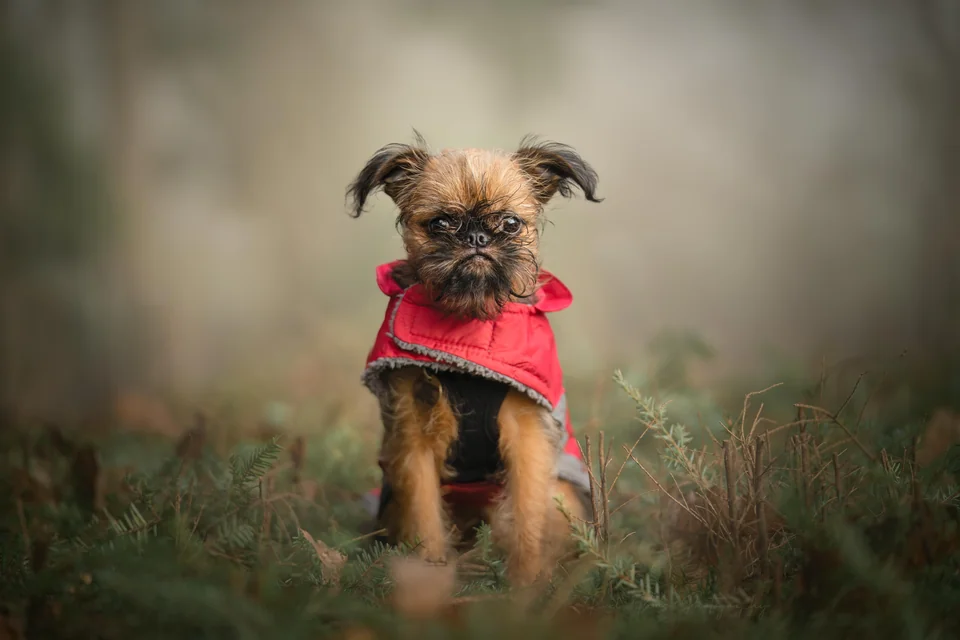
With their distinctive flat faces, Brussels Griffons are prone to specific health issues that owners should consider. This breed can have trouble breathing due to the unique shape of their skull, which affects their airways. They also tend to develop eye problems because of their large, bulging eyes.
Joint conditions like patellar luxation are also more common in these dogs. Owners must proactively look after their Brussels Griffons to prevent or manage these conditions effectively, ensuring their pets a happier, healthier life.
Breathing Issues Risk
Breathing issues are a significant concern for Brussels Griffons, primarily due to their short-nosed facial structure. This physical trait can lead to narrow airways, making it hard for these dogs to breathe, mainly when it’s warm or humid.
Owners must carefully manage their environment and activities to avoid overheating and breathing difficulties. Other health problems like knee issues and skin allergies may also affect their breathing.
Owners need to monitor their pet’s activity and avoid situations that could cause too much barking, which can strain their delicate respiratory system.
Eye Conditions Prevalence
Brussels Griffons often face eye problems such as cataracts and corneal ulcers. These issues require owners to be observant and proactive in their pet’s eye care. The breed’s distinct large eyes are prone to injuries and disorders due to their size and prominence. Regular grooming is necessary for their four coat varieties, but keeping an eye on their ocular health is vital.
Early detection through screening is critical in managing cataracts before they worsen and potentially necessitate surgery. In the case of corneal ulcers, prompt treatment is imperative to avoid further complications. Prospective owners should inquire about the eye health of the puppy’s parents and commit to consistent check-ups with a vet specialized in eye care. Taking steps like shielding them from harsh conditions can help preserve their eye health.
Joint Problems Management
After focusing on eye health, it’s also vital to consider common joint issues in Brussels Griffons, such as patellar luxation and hip dysplasia. These conditions can seriously impact their well-being. While Brussels Griffons are primarily robust, they can be prone to these joint problems.
Patellar luxation, where the kneecap pops out of place, can cause pain and difficulty walking. Hip dysplasia involves poorly formed hip joints, leading to arthritis and ongoing discomfort.
To manage these conditions, keeping your dog at a healthy weight is vital to lessen stress on their joints. Joint supplements can help maintain cartilage, and pain relief may come from anti-inflammatory medicines. Surgery might be the best option in more severe cases to restore the dog’s mobility and comfort—Like Auburn University, veterinary programs often pioneer such surgical techniques.
Maintenance & Grooming
Caring for a Brussels Griffon’s coat is vital to their health and well-being. A regular grooming schedule keeps their unique jacket in good shape. Proper grooming not only makes your dog look great but also helps you keep an eye on the health of their skin.
When grooming your Brussels Griffon, it’s essential to:
- Stick to a consistent grooming routine to keep their coat in prime condition.
- Please choose the right tools and methods that suit their specific coat type.
- Use careful brushing strategies to reduce shedding and prevent tangles.
- Keep their nails trimmed regularly to avoid overgrowth, which can lead to discomfort and other issues.
Grooming Frequency
Grooming Your Brussels Griffon
Caring for your Brussels Griffon involves a good grooming routine to keep their coat looking its best. If you have a smooth-coated variety, a simple weekly brush, and the occasional bath will keep their fur shiny and clean.
On the other hand, if your pet has rough-coated fur, they’ll need to see a groomer more often every 4 to 8 weeks to avoid tangles and maintain the right coat texture. Regular weekly brushing is vital for both coat types to get rid of dead hair and help spread their skin’s natural oils.
Facial fold maintenance is also essential for these dogs. A weekly cleaning of these areas can prevent bacterial or yeast infections, promoting healthy skin.
Coat Care Essentials
Taking care of a Brussels Griffon’s coat is all about understanding the needs of their specific fur type. Suppose you have a rough-coated Brussels Griffon; set aside time every week to brush your wiry hair to prevent tangling and skin problems. This regular grooming is vital to keep their coat’s texture intact.
On the other hand, a smooth-coated Brussels Griffon has a sleek coat that requires less frequent brushing to shed dead hair and keep the fur shiny.
No matter the coat type, each of the four possible colors may have unique grooming requirements. Regular trips to a professional groomer every one to two months are a good practice to ensure their coat stays healthy and complements your at-home care routine.
Brushing Techniques
Brushing your Brussels Griffon correctly is essential to keeping your coat healthy and looking its best. For those with the rough-coated variety, use a pin or slicker brush to untangle and clear out loose fur gently. It’s more than just brushing; it’s about maintaining the coat’s natural texture. Regular brushing prevents tangles and keeps the coat’s natural oils well-distributed.
If you have a smooth-coated Brussels Griffon, a soft bristle brush or grooming mitt will be your tool of choice. These get rid of dead hair and give your dog’s skin a healthy massage. This routine boosts the coat’s shine and keeps shedding under control. Sticking to these grooming habits will keep your Brussels Griffon’s coat pristine.
Nail Trimming Importance
Trimming your Brussels Griffon’s nails is more than just a cosmetic routine; it’s vital for their health and comfort. If a dog’s nails get too long, they can cause the toes to bend in uncomfortable ways, which might lead to joint pain and arthritis over time.
Also, nails that aren’t taken care of can grow into the paw pads, which is painful and can cause infections and problems walking. On a smaller scale, long nails can even affect the nail bed and bones in the paw, changing how the foot works.
Skin Condition Monitoring
Skincare for a Brussels Griffon is critical to their overall health and helps spot problems like allergies, parasites, and infections early. These dogs have thick fur that can hide skin issues, which might appear as itching, redness, or hair loss. Regularly checking your Griffon can help detect pests such as fleas or mites that need specific treatments.
Choosing the proper diet for your Brussels Griffon also affects their skin health. If they eat something they’re intolerant to, it could cause skin reactions. A shiny coat and no skin issues often mark a healthy diet. If you notice anything unusual with your dog’s skin or fur, see a vet quickly to prevent more severe problems.
Dietary Requirements
Caring for your Brussels Griffon’s diet is critical to their health and well-being. It would be best if you created a meal plan that suited their unique requirements, considering their energy needs and any breed-specific issues they might have.
The proper diet includes:
- Picking foods that provide the nutrients specific to Brussels Griffons.
- Figuring out the best feeding schedule to keep their energy consistent and avoid weight gain.
If your dog is prone to allergies, you’ll also need to factor that into their meal plan. It’s also vital to keep an eye on their diet over time, adjusting it based on their age, how active they are, and any changes in their health.
Ideal Food Types
Choosing the right food for your Brussels Griffon is vital to their health and well-being. They thrive on high-quality kibble specially designed for small breeds, ensuring they get the suitable protein, fat, carbs, vitamins, and minerals.
It’s necessary to consider their life stage, size, and how active they are when determining how much to feed them, as these aspects affect their calorie needs. Owners should watch closely how much their dog eats to prevent obesity and avoid health issues like joint problems.
Foods packed with antioxidants help strengthen their immune system, and those with omega fatty acids are great for keeping their fur shiny and skin healthy.
Feeding Frequency
For your Brussels Griffon’s health, you should feed them twice a day. This routine helps control their hunger and keeps them from gaining excess weight.
If your dog spends a lot of time alone, it’s essential to meet their nutritional needs without overfeeding. Measure their high-quality kibble carefully, considering your pet’s size, age, and how active they are.
Regularly reviewing and adjusting meal sizes is critical to avoiding obesity and related health issues. A steady feeding schedule can also prevent stomach problems with unpredictable eating times.
Allergy Considerations
Caring for Brussels Griffons means paying close attention to what they eat to avoid food allergies and maintain their health. These dogs can have reactions like skin problems, scratching, and losing hair. If your Brussels Griffon starts showing these signs, it’s time to look closely at their meals to determine what’s causing the issue.
Picking out dog food with high-quality components that are less likely to cause allergies is intelligent. It’s also essential to monitor how much they eat and how they’re doing after you change their food to control their allergies and stomach issues.
Regular check-ups can help catch allergies early and keep your dog feeling good.

